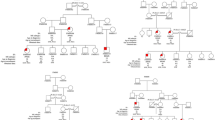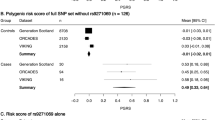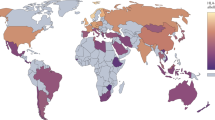Abstract
We have previously found evidence for linkage as well as allelic and haplotype association between the myelin basic protein (MBP) gene and multiple sclerosis (MS). These findings have, however, not been reproduced in other populations. Here, we have analyzed association between MBP and MS in a new set of 349 Finnish triad families. Families with a parent born in the Southern Ostrobothnian region in western Finland (Bothnia families, n=98) were analyzed as a separate group since our previous studies included a high proportion of patients and families from this high-incidence region. Other families (n=251) were collected at five hospitals in southern, eastern, and northern Finland. The MBP short tandem repeat was genotyped, and haplotype patterns were verified by sequencing. In the Bothnia families, the previously detected associations with the 1.27 kb allele and haplotype 1.27-B10 were confirmed (P=0.01 and 0.02, respectively), whereas in the other families there was not even a trend toward association. These results demonstrate a geographic/genealogical restriction in the association between MS and the MBP short tandem repeat, highlight the importance of genealogical information in genetic studies of complex traits, and may provide an explanation why the association has not been found in many other populations.
This is a preview of subscription content, access via your institution
Access options
Subscribe to this journal
Receive 6 digital issues and online access to articles
$119.00 per year
only $19.83 per issue
Buy this article
- Purchase on Springer Link
- Instant access to full article PDF
Prices may be subject to local taxes which are calculated during checkout



Similar content being viewed by others
References
Compston A, Coles A . Multiple sclerosis. Lancet 2002; 359: 1221–1231.
Trapp BD, Bo L, Mork S, Chang A . Pathogenesis of tissue injury in MS lesions. J Neuroimmunol 1999; 98: 49–56.
Sadovnick AD, Dyment D, Ebers GC . Genetic epidemiology of multiple sclerosis. Epidemiol Rev 1997; 19: 99–106.
Compston A, Sawcer S . Genetic analysis of multiple sclerosis. Curr Neurol Neurosci Rep 2002; 2: 259–266.
Olerup O, Hillert J . HLA class II-associated genetic susceptibility in multiple sclerosis: a critical evaluation. Tissue Antigens 1991; 38: 1–15.
Chataway J, Feakes R, Coraddu F et al. The genetics of multiple sclerosis: principles, background and updated results of the United Kingdom systematic genome screen. Brain 1998; 121: 1869–1887.
Ebers GC, Kukay K, Bulman DE et al. A full genome search in multiple sclerosis. Nat Genet 1996; 13: 472–476.
Haines JL, Ter-Minassian M, Bazyk A et al. A complete genomic screen for multiple sclerosis underscores a role for the major histocompatability complex. Nat Genet 1996; 13: 469–471.
Kuokkanen S, Gschwend M, Rioux JD et al. Genomewide scan of multiple sclerosis in Finnish multiplex families. Am J Hum Genet 1997; 61: 1379–1387.
Kuokkanen S, Sundvall M, Terwilliger JD et al. A putative vulnerability locus to multiple sclerosis maps to 5p14–p12 in a region syntenic to the murine locus Eae2. Nat Genet 1996; 13: 477–480.
Larsen F, Oturai A, Ryder LP et al. Linkage analysis of a candidate region in Scandinavian sib pairs with multiple sclerosis reveals linkage to chromosome 17q. Genes Immun 2000; 1: 456–459.
The Transatlantic Multiple Sclerosis Genetics Cooperative. A meta-analysis of genomic screens in multiple sclerosis. Mult Scler 2001; 7: 3–11.
Reunanen K, Finnilä S, Laaksonen M et al. Chromosome 19q13 and multiple sclerosis susceptibility in Finland: linkage and two-stage association study. J Neuroimmunol 2002; 126: 134–142.
Stinissen P, Medaer R, Raus J . Myelin reactive T cells in the autoimmune pathogenesis of multiple sclerosis. Multiple Scleroris 1998; 4: 203–211.
Campagnoni AT, Skoff RP . The pathobiology of myelin mutants reveal novel biological functions of the MBP and PLP genes. Brain Pathol 2001; 11: 74–91.
Boylan KB, Takahashi N, Paty DW et al. DNA length polymorphism 5′ to the myelin basic protein gene is associated with multiple sclerosis. Ann Neurol 1990; 27: 291–297.
Tienari PJ, Wikstrom J, Sajantila A, Palo J, Peltonen L . Genetic susceptibility to multiple sclerosis linked to myelin basic protein gene. Lancet 1992; 340: 987–991.
Rose J, Gerken S, Lynch S et al. Genetic susceptibility in familial multiple sclerosis not linked to the myelin basic protein gene. Lancet 1993; 341: 1179–1181.
Eoli M, Pandolfo M, Milanese C, Gasparini P, Salmaggi A, Zeviani M . The myelin basic protein gene is not a major susceptibility locus for multiple sclerosis in Italian patients. J Neurol 1994; 241: 615–619.
Wood NW, Holmans P, Clayton D, Robertson N, Compston DA . No linkage or association between multiple sclerosis and the myelin basic protein gene in affected sibling pairs. J Neurol Neurosurg Psychiatry 1994; 57: 1191–1194.
Seboun E, Oksenberg JR, Rombos A et al. Linkage analysis of candidate myelin genes in familial multiple sclerosis. Neurogenetics 1999; 2: 155–162.
Graham CA, Kirk CW, Nevin NC et al. Lack of association between myelin basic protein gene microsatellite and multiple sclerosis. Lancet 1993; 341: 1596 (letter).
Vandevyver C, Stinissen P, Cassiman JJ, Raus J . Myelin basic protein gene polymorphism is not associated with chronic progressive multiple sclerosis. J Neuroimmunol 1994; 52: 97–99.
Barcellos LF, Thomson G, Carrington M et al. Chromosome 19 single-locus and multilocus haplotype associations with multiple sclerosis. Evidence of a new susceptibility locus in Caucasian and Chinese patients. JAMA 1997; 278: 1256–1261.
Price SE, Sharpe G, Boots A et al. Role of myelin basic protein and proteolipid protein genes in multiple sclerosis: single strand conformation polymorphism analysis of the human sequences. Neuropathol Appl Neurobiol 1997; 23: 457–467.
He B, Yang B, Lundahl J, Fredrikson S, Hillert J . The myelin basic protein gene in multiple sclerosis: identification of discrete alleles of a 1.3 kb tetranucleotide repeat sequence. Acta Neurol Scand 1998; 97: 46–51.
Tienari PJ, Kuokkanen S, Pastinen T et al. Golli-MBP gene in multiple sclerosis susceptibility. J Neuroimmunol 1998; 81: 158–167.
Ibsen SN, Clausen J . A repetitive DNA sequence 5′ to the human myelin basic protein gene may be linked to MS in Danes. Acta Neurol Scand 1996; 93: 236–240.
Guerini FR, Losciale L, Mediati M et al. A polymorphism in the repetitive (TGGA)n sequence 5′ to the human myelin basic protein gene in Italian multiple sclerosis patients. J Neurovirol 2000; 6 (Suppl 2): 28–32.
Boylan KB, Ayres TM, Popko B, Takahashi N, Hood LE, Prusiner SB . Repetitive DNA (TGGA)n 5′ to the human myelin basic protein gene: a new form of oligonucleotide repetitive sequence showing length polymorphism. Genomics 1990; 6:16–22.
Gusmão L, Amorim A, Prata MJ, Pereira L, Lareu MV, Carracedo A . Failed PCR amplifications of MBP-STR alleles due to polymorphism in the primer annealing region. Int J Legal Med 1996; 108: 313–315.
Ellegren H . Microsatellite mutations in the germline: implications for evolutionary inference. Trends Genet 2000; 16: 551–558.
Sumelahti ML, Tienari PJ, Wikström J, Palo J, Hakama M . Regional and temporal variation in multiple sclerosis incidence in Finland during 1979–93. Neuroepidemiology 2000; 19: 67–75.
Sumelahti ML, Tienari PJ, Palo Jorma, Wikström J, Hakama M . Increasing prevalence of multiple sclerosis in Finland. Acta Neurol Scand 2001; 103: 153–158.
Coppin H, Ribouchon MT, Bausero P et al. No evidence for transmission disequilibrium between a new marker at the myelin basic protein locus and multiple sclerosis in French patients. Genes Immun 2000; 1: 478–482.
Peltonen L, Palotie A, Lange K . Use of population isolates for mapping complex traits. Nat Rev Genet 2000; 1: 182–190.
Wikström J, Palo J . Studies on the clustering of multiple sclerosis in Finland II: comparison between the domiciles and places of birth in selected subpopulations. Acta Neurol Scand 1975; 51: 85–98.
Wikström J, Palo J . Studies on the clustering of multiple sclerosis in Finland II: Microepidemiology in one high-risk county with special reference to familial cases. Acta Neurol Scand 1975; 51: 173–183.
Wikström J, Kinnunen E, Porras J . The age-specific prevalence ratio of familial multiple sclerosis. Neuroepidemiology 1984; 3: 74–82.
Sumelahti ML, Tienari PJ, Hakama M, Wikström J . MS in Finland: incidence trends and differences in relapsing remitting and primary progressive disease courses. J Neurol Neurosurg Psychiatry (in press).
Laaksonen M, Pastinen T, Sjöroos M et al. HLA class II associated risk and protection against multiple sclerosis—a Finnish family study. J Neuroimmunol 2002; 122: 140–145.
Tienari PJ, Wikström J, Koskimies S, Partanen J, Palo J, Peltonen L . Reappraisal of HLA in multiple sclerosis: close linkage in multiplex families. Eur J Hum Genet 1993; 1: 257–268.
Möller A, Wiegand P, Grüschow C, Seuchter SA, Baur MP, Brinkmann B . Population data and forensic efficiency values for the STR systems HumVWA, HumMBP and HumFABP. Int J Legal Med 1994; 106: 183–189.
Terwilliger JD, Zollner S, Laan M, Paabo S . Mapping genes through the use of linkage disequilibrium generated by genetic drift: ‘drift mapping’ in small populations with no demographic expansion. Hum Hered 1998; 48: 138–154.
Kaessmann H, Zollner S, Gustafsson AC et al. Extensive linkage disequilibrium in small human populations in Eurasia. Am J Hum Gen 2002; 70: 673–685.
Luukko A . The historical settlement of Southern Ostrobothnia. In: The Southern Ostrobothnian History-Committee (ed). The History of Southern Ostrobothnia. Maalaiskuntien Liiton Kirjapaino: Helsinki, 1950, pp 1–81 (in Finnish).
Compston A . The story of multiple sclerosis. In: Compstron A, Ebers G, Lassmann H, McDonald, Matthews B, Wekerle H (eds). McAlpine's Multiple Sclerosis. Churchill-Livingstone: New York, 1999, pp 3–42.
Westman P, Kuismin T, Partanen J, Koskimies S . An HLA-DR typing protocol using group-specific PCR-amplification followed by restriction enzyme digests. Eur J Immunogenet 1993; 20: 103–109.
Clayton D . A generalization of the transmission/disequilibrium test for uncertain-haplotype transmission. Am J Hum Genet 1999; 65: 1170–1177.
Acknowledgements
We are indebted to the patients and their families for participation in the study. Ms Seija Ahlbäck is acknowledged for her efforts in recruiting Bothnia families for this study, Ms Minna Virta and Ms Lilja Erola for excellent technical assistance. This study was financially supported by grants from the Finnish Academy (PJT), The Center of Excellence for Disease Genetics of the Academy of Finland (LP), the Multiple Sclerosis Foundation of US (LP), the Sigrid Juselius Foundation (PJT), the Helsinki University Central Hospital, and the Finnish Cultural Foundation (PJT).
Author information
Authors and Affiliations
Corresponding author
Rights and permissions
About this article
Cite this article
Pihlaja, H., Rantamäki, T., Wikström, J. et al. Linkage disequilibrium between the MBP tetranucleotide repeat and multiple sclerosis is restricted to a geographically defined subpopulation in Finland. Genes Immun 4, 138–146 (2003). https://doi.org/10.1038/sj.gene.6363943
Received:
Revised:
Accepted:
Published:
Issue Date:
DOI: https://doi.org/10.1038/sj.gene.6363943
Keywords
This article is cited by
-
Identity-by-descent mapping in a Scandinavian multiple sclerosis cohort
European Journal of Human Genetics (2015)
-
Gene expression profiles in Finnish twins with multiple sclerosis
BMC Medical Genetics (2006)
-
A two-stage study on multiple sclerosis susceptibility and chromosome 2q33
Genes & Immunity (2004)



